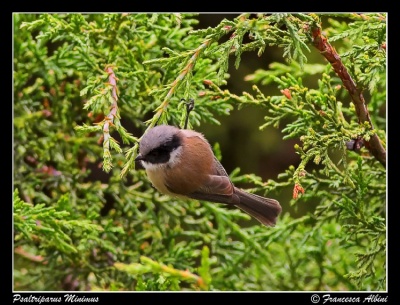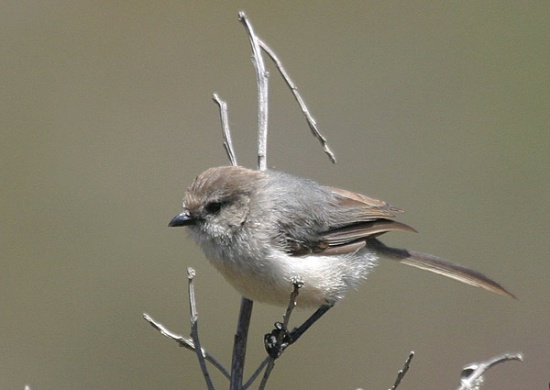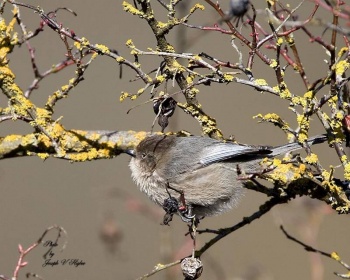m (Image first) |
Nutcracker (talk | contribs) (format) |
||
| Line 2: | Line 2: | ||
;[[: Category:Psaltriparus|Psaltriparus]] minimus | ;[[: Category:Psaltriparus|Psaltriparus]] minimus | ||
==Identification== | ==Identification== | ||
| − | One of [[North America]]'s smallest birds | + | One of [[North America]]'s smallest birds other than hummingbirds, only 10-11 cm in length, nearly half of which is the long, narrow tail. Its weight is only 4.5-6 g<br /> |
Eyes are dark in the male, but cream to yellowish in the female.<br /> | Eyes are dark in the male, but cream to yellowish in the female.<br /> | ||
| − | Coastal birds have brown crowns; interior birds are more gray overall with brown cheeks. Birds from southern [[Texas]] southward | + | Coastal birds have brown crowns; interior birds are more gray overall with brown cheeks. Birds from southern [[Texas]] southward have black masks in males, dusky masks in females. |
[[Image:Black-eared_Bushtit_by_gatafrancesca.jpg|thumb|400px|right|Male "Black-eared Bushtit"<br />Photo by {{user|gatafrancesca|gatafrancesca}}<br />San Cristóbal de Las Casas, Chiapas, [[Mexico]], November 2006]] | [[Image:Black-eared_Bushtit_by_gatafrancesca.jpg|thumb|400px|right|Male "Black-eared Bushtit"<br />Photo by {{user|gatafrancesca|gatafrancesca}}<br />San Cristóbal de Las Casas, Chiapas, [[Mexico]], November 2006]] | ||
==Distribution== | ==Distribution== | ||
| − | + | Southwestern [[British Columbia]] and south through western [[USA]] (east to western [[Texas]]) and [[Mexico]] to [[Guatemala]]. | |
==Taxonomy== | ==Taxonomy== | ||
====Subspecies==== | ====Subspecies==== | ||
| − | The Bushtit has | + | The Bushtit has 10-12 subspecies depending on authority<sup>[[#References|[1]]]</sup><sup>[[#References|[2]]]</sup><sup>[[#References|[3]]]</sup>: |
| − | The forms with black mask (subspecies including at least ''melanotis'' and ''personatus'') | + | The forms with black mask (subspecies including at least ''P. m. melanotis'' and ''P. m. personatus'') were formely considered a distinct species, the Black-eared Bushtit ''P. melanotis''. There is a complex transition zone between this and the northern forms. |
[[Image:117505-00216cobuf053.jpg|thumb|350px|right|Female<br />Photo by {{user|jvhigbee|jvhigbee}}<br />[[Nisqually National Wildlife Refuge]], Washington, [[USA]], February 2005]] | [[Image:117505-00216cobuf053.jpg|thumb|350px|right|Female<br />Photo by {{user|jvhigbee|jvhigbee}}<br />[[Nisqually National Wildlife Refuge]], Washington, [[USA]], February 2005]] | ||
| − | ''' | + | '''P. m. minimus Group''' (Pacific) |
*''P. m. saturatus''':Southern [[British Columbia]], Puget Sound lowlands and Whidbey Island | *''P. m. saturatus''':Southern [[British Columbia]], Puget Sound lowlands and Whidbey Island | ||
*''P. m. minimus'': Pacific coast west of the Cascades (northern [[Oregon]] to southern [[California]]) | *''P. m. minimus'': Pacific coast west of the Cascades (northern [[Oregon]] to southern [[California]]) | ||
*''P. m. melanurus'': Coastal southern [[California]] (northern San Diego County) to northern [[Baja]] | *''P. m. melanurus'': Coastal southern [[California]] (northern San Diego County) to northern [[Baja]] | ||
*''P. m. grindae'': Mountains southern [[Baja California]] (Sierra de la Laguna)<br /> | *''P. m. grindae'': Mountains southern [[Baja California]] (Sierra de la Laguna)<br /> | ||
| − | ''' | + | '''P. m. plumbeus Group''' (Interior) |
*''P. m. plumbeus'': Eastern [[Oregon]] to [[Idaho]], [[Wyoming]], [[Arizona]], [[New Mexico]], western [[Texas]] | *''P. m. plumbeus'': Eastern [[Oregon]] to [[Idaho]], [[Wyoming]], [[Arizona]], [[New Mexico]], western [[Texas]] | ||
*''P. m. californicus'': Interior southern [[Oregon]] to southern [[California]] (Kern County) | *''P. m. californicus'': Interior southern [[Oregon]] to southern [[California]] (Kern County) | ||
*''P. m. sociabilis'': Southern [[California]] (Little San Bernardino and Eagle mountains)<br /> | *''P. m. sociabilis'': Southern [[California]] (Little San Bernardino and Eagle mountains)<br /> | ||
| − | ''' | + | '''P. m. melanotis Group (Black-eared)''' |
*''P. m. dimorphicus'': Mountains of north-western [[Mexico]] (Sonora to Sinaloa and northern Coahuila) | *''P. m. dimorphicus'': Mountains of north-western [[Mexico]] (Sonora to Sinaloa and northern Coahuila) | ||
*''P. m. iulus'': Mountains of western [[Mexico]] (Durango to southern Jalisco and western Tamaulipas) | *''P. m. iulus'': Mountains of western [[Mexico]] (Durango to southern Jalisco and western Tamaulipas) | ||
| Line 31: | Line 31: | ||
A study shows genetic divisions within this species possibly indicating a future split. | A study shows genetic divisions within this species possibly indicating a future split. | ||
==Habitat== | ==Habitat== | ||
| − | Two populations differ in using scrub along the coast, and mainly | + | Two populations differ in using scrub along the coast, and mainly oak-pine woodlands in the mountains. Southern populations especially are limited to higher altitudes in mountains. |
==Behaviour== | ==Behaviour== | ||
| − | These birds roam in flocks, flowing from one tree to the next, keeping the group together with a constant chatter of calls. | + | These birds roam in flocks, flowing from one tree to the next, keeping the group together with a constant chatter of calls. They are non-migratory, but may move to lower elevations in the colder months. Gregarious except when breeding. Groups are often seen huddled together on nightly roosts to conserve body heat. |
====Diet==== | ====Diet==== | ||
Food is mostly insects and spiders with some small seeds, galls, and other vegetable matter mixed in. Food is usually caught by [[Dictionary_G-L#G|gleaning]], and the majority of time is spent gleaning from leaves with the rest being on small twigs near the tip of a branch. Type of preferred tree differs regionally and with the time of year; sometimes the birds prefer flowering trees due to the insects attracted to the flowers. | Food is mostly insects and spiders with some small seeds, galls, and other vegetable matter mixed in. Food is usually caught by [[Dictionary_G-L#G|gleaning]], and the majority of time is spent gleaning from leaves with the rest being on small twigs near the tip of a branch. Type of preferred tree differs regionally and with the time of year; sometimes the birds prefer flowering trees due to the insects attracted to the flowers. | ||
====Breeding==== | ====Breeding==== | ||
| − | Nest is a hanging sack constructed of | + | Nest is a hanging sack constructed of spiders' webs and vegetable matter. One to two clutches per year, usually reusing the same nest. Brood size is 4-10, usually smaller in south than in north part of the range; when applicable, second clutch is laid while the young of the first clutch is still dependent on the parents. Some pairs get help to bring up the young from other birds, which can be of either sex and adults or young, and are usually siblings or other close relatives. |
====Vocalisation==== | ====Vocalisation==== | ||
Bushtits don’t have a song in the usual sense, but they do make a lot of contact calls, typically ''tsit'' or ''spit'', which vary in loudness and frequency, depending on the situation. For instance, soft calls are made in foraging flocks to help individuals know where their flockmates are. Louder calls are heard in nest building activity and during mobbing behavior. | Bushtits don’t have a song in the usual sense, but they do make a lot of contact calls, typically ''tsit'' or ''spit'', which vary in loudness and frequency, depending on the situation. For instance, soft calls are made in foraging flocks to help individuals know where their flockmates are. Louder calls are heard in nest building activity and during mobbing behavior. | ||
| Line 45: | Line 45: | ||
Soft twittering calls can occasionally be heard when several Bushtits huddle together. | Soft twittering calls can occasionally be heard when several Bushtits huddle together. | ||
==References== | ==References== | ||
| − | #{{Ref-Clements6thAug11}}#[http://www.barcodeoflife.org/barcode/batsbirds/literature/MEN1670_final.pdf Paper] describing genetic findings with this species | + | #{{Ref-Clements6thAug11}}#{{Ref-GillDonsker14V5.2}}#{{Ref-HBWVol13}}#[http://www.barcodeoflife.org/barcode/batsbirds/literature/MEN1670_final.pdf Paper] describing genetic findings with this species |
#Birds of North America Online account for Bushtit | #Birds of North America Online account for Bushtit | ||
{{ref}} | {{ref}} | ||
Revision as of 22:51, 14 June 2015
- Psaltriparus minimus
Identification
One of North America's smallest birds other than hummingbirds, only 10-11 cm in length, nearly half of which is the long, narrow tail. Its weight is only 4.5-6 g
Eyes are dark in the male, but cream to yellowish in the female.
Coastal birds have brown crowns; interior birds are more gray overall with brown cheeks. Birds from southern Texas southward have black masks in males, dusky masks in females.

Photo by gatafrancesca
San Cristóbal de Las Casas, Chiapas, Mexico, November 2006
Distribution
Southwestern British Columbia and south through western USA (east to western Texas) and Mexico to Guatemala.
Taxonomy
Subspecies
The Bushtit has 10-12 subspecies depending on authority[1][2][3]:
The forms with black mask (subspecies including at least P. m. melanotis and P. m. personatus) were formely considered a distinct species, the Black-eared Bushtit P. melanotis. There is a complex transition zone between this and the northern forms.
P. m. minimus Group (Pacific)
- P. m. saturatus':Southern British Columbia, Puget Sound lowlands and Whidbey Island
- P. m. minimus: Pacific coast west of the Cascades (northern Oregon to southern California)
- P. m. melanurus: Coastal southern California (northern San Diego County) to northern Baja
- P. m. grindae: Mountains southern Baja California (Sierra de la Laguna)
P. m. plumbeus Group (Interior)
- P. m. plumbeus: Eastern Oregon to Idaho, Wyoming, Arizona, New Mexico, western Texas
- P. m. californicus: Interior southern Oregon to southern California (Kern County)
- P. m. sociabilis: Southern California (Little San Bernardino and Eagle mountains)
P. m. melanotis Group (Black-eared)
- P. m. dimorphicus: Mountains of north-western Mexico (Sonora to Sinaloa and northern Coahuila)
- P. m. iulus: Mountains of western Mexico (Durango to southern Jalisco and western Tamaulipas)
- P. m. personatus: Mountains of central Mexico (Michoacán to western Veracruz and Puebla)
- P. m. melanotis: Mountains of southern Mexico (Guerrero, Oaxaca and Chiapas) to Guatemala
A study shows genetic divisions within this species possibly indicating a future split.
Habitat
Two populations differ in using scrub along the coast, and mainly oak-pine woodlands in the mountains. Southern populations especially are limited to higher altitudes in mountains.
Behaviour
These birds roam in flocks, flowing from one tree to the next, keeping the group together with a constant chatter of calls. They are non-migratory, but may move to lower elevations in the colder months. Gregarious except when breeding. Groups are often seen huddled together on nightly roosts to conserve body heat.
Diet
Food is mostly insects and spiders with some small seeds, galls, and other vegetable matter mixed in. Food is usually caught by gleaning, and the majority of time is spent gleaning from leaves with the rest being on small twigs near the tip of a branch. Type of preferred tree differs regionally and with the time of year; sometimes the birds prefer flowering trees due to the insects attracted to the flowers.
Breeding
Nest is a hanging sack constructed of spiders' webs and vegetable matter. One to two clutches per year, usually reusing the same nest. Brood size is 4-10, usually smaller in south than in north part of the range; when applicable, second clutch is laid while the young of the first clutch is still dependent on the parents. Some pairs get help to bring up the young from other birds, which can be of either sex and adults or young, and are usually siblings or other close relatives.
Vocalisation
Bushtits don’t have a song in the usual sense, but they do make a lot of contact calls, typically tsit or spit, which vary in loudness and frequency, depending on the situation. For instance, soft calls are made in foraging flocks to help individuals know where their flockmates are. Louder calls are heard in nest building activity and during mobbing behavior.
If an individual is separated from the flock, it will give a high-pitched, bell-like call which carries a long distance.
Soft twittering calls can occasionally be heard when several Bushtits huddle together.
References
- Clements, JF. 2011. The Clements Checklist of Birds of the World. 6th ed., with updates to August 2011. Ithaca: Cornell Univ. Press. ISBN 978-0801445019. Spreadsheet available at http://www.birds.cornell.edu/clementschecklist/downloadable-clements-checklist
- Gill, F and D Donsker (Eds). 2015. IOC World Bird Names (version 5.2). Available at http://www.worldbirdnames.org/.
- Del Hoyo, J, A Elliott, and D Christie, eds. 2008. Handbook of the Birds of the World. Volume 13: Penduline-tits to Shrikes. Barcelona: Lynx Edicions. ISBN 978-8496553453
- Paper describing genetic findings with this species
- Birds of North America Online account for Bushtit
Recommended Citation
- BirdForum Opus contributors. (2024) Bushtit. In: BirdForum, the forum for wild birds and birding. Retrieved 25 April 2024 from https://www.birdforum.net/opus/Bushtit





